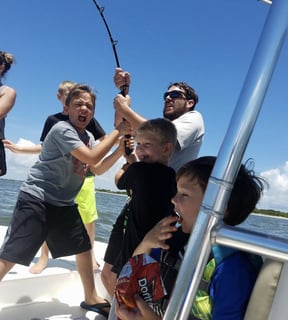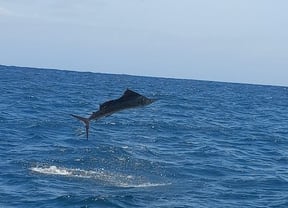We started Captain Experiences to make it easy to book fishing and hunting guides around the world. With over 1,500 Damn Good Guides, our platform makes finding and booking a trip seamless. Head here to check out our trips.
Beginner's Guide to Fishing: Landing Fish
Hooking into a fish and fighting them back to the boat is exhilarating and drives many people to love the sport. Once the fish is boat side, however, sealing the deal can get tricky. It’s not uncommon for mistakes to happen during the landing process, and losing a fish at the boat is earth-shattering. To help you avoid costly mistakes, here are the most effective ways to securely land fish.

Boat Flip
The boat flip is simply bringing the fish onboard by lifting it out of the water and onto the deck of the boat using nothing more than the rod and reel. This slick move is a favorite among freshwater and inshore anglers when fish are small enough that they won't break the line. Knowing the strength of your rod and line is crucial to estimating whether a fish can be safely lifted from the water with the line. If you overestimate, the fish will likely not make it on the boat, and your line or rod can break. The boat flip is smooth and efficient but should only be used when you’re sure the tackle is up to the task.
Netting Fish
For everything except the largest fish, using a net may be the best option. Scooping a fish into the net solo requires skill, but with the help of a buddy, it's easy and effective. Having the fish in the net is great because it provides the angler with options of what to do with the fish. If they want to keep the fish, they can simply haul the net into the boat. If they want to release it, they can work on unhooking the fish in the water or onboard.
Gaff
The gaff is one of the most popular landing devices for offshore fishing, but it should only be used on fish destined for the cooler. A gaff is a large, sharp hook on the end of a handle ranging from two to six feet long. The point of the gaff is hooked into the side of the fish and used to lift them into the boat. Due to the obvious damage inflicted on the fish, releasing them would be unethical. If you plan to keep the fish, the gaff is one of the most useful and secure tools for putting fish on the deck.
Tail Rope
The tail rope is most commonly used in addition to a gaff. The tail rope is a strong rope with a slip knot tied to the end. The loop of the knot is slipped over the tail of large fish once they are next to the boat. The tail rope is tied off to the boat to ensure the fish doesn’t break off, while also giving anglers the chance to bleed out their catch. The tail rope also doubles as a strong lifting point. With the help of some friends with gaffs, multiple people can lift huge fish out of the water and onto the boat.
Landing Fish
Landing fish can be done in a variety of ways, but choose a method only after carefully considering the size of fish in the area and whether you intend to retain your catch. While boat flips can look cool, getting it wrong can be costly. Nets are one of the most popular options and are often used to safely land fish ranging from less than a pound to well over 100 pounds. If you love to eat fish, then a gaff is a great tool to have and offers quick secure landings. While a tail rope is just a rope with a knot on the end, it's a great thing to have ready if a giant decides to strike.
That being said, the landing process can also be stressful. Hiring a guide can help you learn how it’s done.
Joey Butrus
Updated on August 2, 2023

January 4, 2022

April 15, 2022

August 1, 2022

December 10, 2021

June 22, 2022
Related Articles
December 15, 2022
July 18, 2022
November 27, 2022


